The Poetic Edda: A Study Guide
The Speech of the Masked One
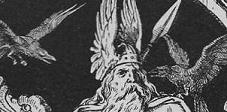
[PREVIOUS][MAIN][NEXT]
[HOME]
MS No. 2365 4to [R]
AM 748 I 4to [A]
Normalized Text:
Ór ymis holdi
var jörð vm sköpuð,
en ór sveita sær,
björg ór beinum,
baðmr ór hári,
en ór hausi himinn.
En ór hans brám
gerðu blíð regin
miðgarð manna sonum;
en ór hans heila
váru þau in harðmóðgu
ský öll of sköpuð.
Ór ýmis hölldi
var jörð of sköpuð,
en ór sveita siór,
björg ór beinum,
baðmr ór hári,
en ór her himinn.
En ór hans brám
gerðu blíð regin
Miðgarð manna sonum;
en ór hans heila
váru þau in harðmóðgu
ský öll of sköpuð.
40. Ór Ymis holdi
var jörð of sköpuð,
en ór sveita sær,
björg ór beinum,
baðmr ór hári,
en ór hausi himinn.
41. En ór hans brám
gerðu blíð regin
Miðgarð manna sonum;
en ór hans heila
váru þau in harðmóðgu
ský öll of sköpuð.
in Icelandic Poetry
“The Song of Grimnir”
The Yale Magazine, Vol. 16
“The Song of Grimner”
At first the variegated earth,
From flesh of Ymer had his birth;
His blood supplied the ocean bed;
His bones the rocky mountains bred;
Transform'd to herbs his hair was seen;
His skull o'er-arch'd the blue serene;
For man, propitious Deities
Pluck'd the shadowings of his eyes,
And Midgar form'd that happy zone,
Which heat and cold alike have flown;
Dun vapors from his brain exhaled,
And clouds in scatter'd squadrons sail'd ---
Black clouds that in their bosoms bore
The germs of elemental war.
The earth, and from his blood the raging sea,
The rocks from his bones, and from his hair
the trees,
And plants; his skull became the vaulted heaven;
And Midgard, from his fringed lids, the gods
Kindly have fashioned for the sons of men;
And from his brain, the clouds that dress the sky
Of Summer, or dart their lightnings in the storm,
Their first substance had.
in Edda Sæmundar Hinns Frôða
“The Lay of Grimnir”
in Corpus Poeticum Boreale
“The Sayings of the Hooded One”
40. Of Ymir’s flesh
was earth created,
of his blood the sea,
of his bones the hills,
of his hair trees and plants,
of his skull the heaven;
41. and of his brows
the gentle powers
formed Midgard for the sons of men;
but of his brain
the heavy clouds are
all created.
in Edda Saemundar
“The Sayings of Grimnir”
in The Poetic Edda
“Grimnismol: The Ballad of Grimnir”
from his blood the billows of the sea,
the hills from his bones, the trees from his hair,
the sphere of heaven from his skull.
41. [1] Out of his brows the blithe Powers made
Midgarth for sons of men,
and out of his brains were the angry clouds
all shaped above in the sky.
[1] 40, 41. One strophe R.
And the ocean out of his blood;
Of his bones the hills, of his hair the trees,
Of his skull the heavens high.
41. Mithgarth the gods from his eyebrows made,
And set for the sons of men;
And out of his brain the baleful clouds
They made to move on high.
in The Poetic Edda
“The Lay of Grimnir”
in The Elder Edda
“The Lay of Grimnir”
of his blood, the briny sea,
of his hair, the trees, the hills of his bones,
out of his skull the sky.
42. But of his lashes the loving gods made
Mithgarth for sons of men;
from his brow they made the menacing clouds
which in the heavens hover.
From his blood the salt sea,
The fells from his bones, the forests from his hair,
The arching sky from his skull
From his eyelashes the High Ones
Made Middle-Earth for men,
And out of his brains the ugly-tempered
Clouds were all carved.
in The Poetic Edda
“Grimnir’s Sayings”
in The Poetic Edda, Vol. III: Mythological Poems
“The Lay of Grimnir”
40. From Ymir's flesh the earth was made,*
and from his blood, the sea,
mountains from his bones, trees from his hair,
and from his skull, the sky.
41. And from his eyelashes the cheerful gods
made earth in the middle for men;
and from his brain were the hard-tempered clouds
all made.
40. From Ymir’s flesh
earth was formed
and from his blood the sea,
mountains from his bones,
branches from his hair,
and from his skull the sky.
41. And from his eyelashes
the amiable powers made
Miðgardr for men’s sons,
and from his brain
the bitter-tempered
clouds were all created.
The Elder Edda: A Book of Viking Lore
'The Lay of Grimnir"
40. ‘From Ymir’s flesh the earth was formed,
and from his blood the sea;
rocks from bones, trees from hair,
and from his skull the sky.
41. ‘And from his brows the kind powers made
middle-earth for the sons of men;
and from his brain, the cruel hearted
clouds were all created.
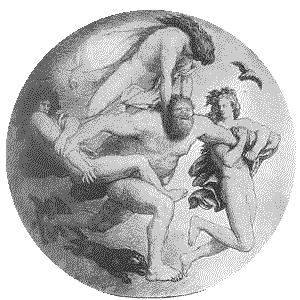
[HOME][GRÍMNISMÁL]
Both stanzas are quoted in full in Gylfaginning 8.
The gods are collectively designated as blið regin in Grímnismál 6, 37 and 41, as well as in Lokasenna 32.
Guðrún Nordal, Tools of Literacy, (2001), pp. 277-285:
| "These two stanzas seem
to be misplaced in Grímnismál and have been considered by some
scholars to be interpolations, and the second stanza even a
later addition to the poem [e.g. Sijmons and Gering, 207]; they
seem to interupt the narrative sequence. It is clearly
impossible to ascertain the original composition of these
stanzas, which may have been transmitted orally before they were
committed to writing." "...Outside of Snorra Edda, the myth of Ymir is advanced only by these two stanzas in Grímnismál (40-1 and Vafþrúðnismál 21). The earth is created from Ymir's hold ('flesh'), and consequently kennings associated with Ymir's body which denote the heaven, earth and sea, entered after kennings for the gods in Skáldskáparmál." "Two of the sections on the cosmos begin with skaldic examples drawn from the myth of Ymir, which indicates superiority of this type of kenning, in the framework of the Snorra Edda. A stanza by Arnórr jarlaskáld, printed by Finnur Jónsson as the nineteenth stanza of Magnúsdrápa, contains the kenning Ymis hauss ('Ymir's head') for the sky, only cited in Snorri Edda." "The kenning Ymis blóð ("Ymir's blood') occurs in one of two skaldic fragments attributed to the unknown Ormr Barreyjarskáld, a hero of the story told by Ingimundr Einarsson at the wedding at Reykjahólar in the summer of 1119." "There is no known kenning for earth as Ymis hold ('the flesh of Ymir'). Earth is sometimes referred to by the oblique reference to the goddess Jörð ....Hold figures in a mythological kenning for earth in a stanza by Eyvindr skáldaspillir, preserved in its entirety in Heimskringla, which is also a referennce to Thor's mother Jörð." "...The image of the world as a gigantic human body permeates body imagery in skaldic verse. There are rarely any explicit allusions to the body of the giant Ymir in skaldic diction, as I noted above, yet it seems that the figure of a giant or the concept of the world-body reminiscent of that proposed by Neo-platonists underlies—or sustains— this type of imagery in skaldic poetry." |
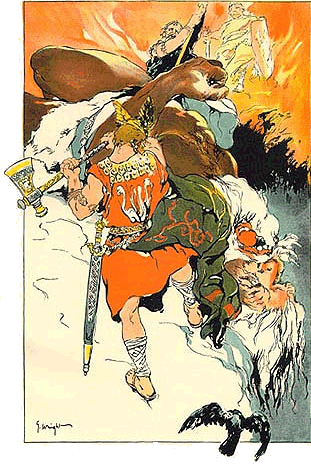 |
|
Vafþrúðnir kvað: 21. |
Vafthrudnir said: 21. "From Ymir's flesh |
| Ár var alda þar er Ymir byggði, vara sandr né sær né svalar unnir. Jörð fannsk æva né upphiminn, gap var ginnunga, en gras hvergi. |
When time was young where Ymir dwelt, There was no sand, no sea, nor cool waves; Earth was not found, nor heaven above, a chasm was gaping, and grass nowhere. |
Although, in Gylfaginning 3, Snorri Sturlusson cites a variant of the stanza which excludes Ymir:
|
Ár var alda |
When time was young what is was not There was no sand, no sea nor cool wave. Earth was not found nor heaven above, a chasm was gaping and grass nowhere. |
| "In 3/2 Snorri has ekki var (SnE 11, in all MSS), as against R, H Ymir byggði, Snorri might have known a now lost Old Norse poem about the primordial world in which the line þar/þat er ekki var occurred —cf Wessobrunn Prayer 6: Do dar niuuiht uuas— or he might have invented it himself; but it is unlikely that it occurred in the poet's text of Völuspá. We may note that Snorri cites this stanza when he is describing the cosmos before Ymir was formed in it (SnE 12). If Ymir's name stood here in the text Snorri was using, he would have to remove it, as he had not yet mentioned Ymir in his prose. I suppose that is what he did." |
The origin, history and fate of the primeval giant known both as Ymir is told by Snorri in Gylfaginning 5-8
[Broduer translation]:
| V. ...Svá sem kalt stóð af Niflheimi ok allir hlutir grimmir, svá var allt þat, er vissi námunda Múspelli, heitt ok ljóst, en Ginnungagap var svá hlætt sem loft vindlaust. Ok þá er mættist hrímin ok blær hitans, svá at bráðnaði ok draup, ok af þeim kvikudropum kviknaði með krafti þess, er til sendi hitann, ok varð manns líkandi, ok var sá nefndr Ymir, en hrímþursar kalla hann Aurgelmi, ok eru þaðan komnar ættir hrímþursa | 5. ... Just as cold arose out of Niflheim, and all terrible things, so also all that looked toward Múspellheim became hot and glowing; but Ginnungagap was as mild as windless air, and when the breath of heat met the rime, so that it melted and dripped, life was quickened from the yeast-drops, by the power of that which sent the heat, and became a man's form. And that man is named Ymir, but the Rime-Giants call him Aurgelimir; and thence are come the races of the Rime-Giants... | ||
| VI. Þá mælti Gangleri: "Hvar byggði Ymir, eða við hvat lifði hann?" Hárr svarar: "Næst var þat, þá er hrímit draup, at þar varð af kýr sú, er Auðhumla hét, en fjórar mjólkár runnu ór spenum hennar, ok fæddi hon Ymi." Þá mælti Gangleri: "Við hvat fæddist kýrin?" Hárr svarar: "Hon sleikði hrímsteinana, er saltir váru, ok inn fyrsta dag, er hon sleikði steinana, kom ór steininum at kveldi manns hár, annan dag manns höfuð, þriðja dag var þar allr maðr. Sá er nefndr Búri. Hann var fagr álitum, mikill ok máttugr. Hann gat son þann, er Borr hét, hann fekk þeirar konu, er Bestla hét, dóttir Bölþorns jötuns, ok fengu þau þrjá sonu. Hét einn Óðinn, annarr Vili, þriði Vé, ok þat er mín trúa, at sá Óðinn ok hans bræðr munu vera stýrandi himins ok jarðar. Þat ætlum vér, at hann myni svá heita. Svá heitir sá maðr, er vér vitum mestan ok ágæztan, ok vel meguð þér hann láta svá heita." | 6. Then said Gangleri: "Where dwelt Ymir, or wherein did he find sustenance?" Hárr answered: "Straightway after the rime dripped, there sprang from it the cow called Audumla; four streams of milk ran from her udders, and she nourished Ymir." Then asked Gangleri: "Wherewithal was the cow nourished?" And Hárr made answer: "She licked the ice-blocks, which were salty; and the first day that she licked the blocks, there came forth from the blocks in the evening a man's hair; the second day, a man's head; the third day the whole man was there. He is named Búri: he was fair of feature, great and mighty. He begat a son called Borr, who wedded the woman named Bestla, daughter of Bölthorn the giant; and they had three sons: one was Odin, the second Vili, the third Vé. And this is my belief, that he, Odin, with his brothers, must be ruler of heaven and earth; we hold that he must be so called; so is that man called whom we know to be mightiest and most worthy of honor, and ye do well to let him be so called." | ||
| VII. ...Synir Bors drápu Ymi jötun, en er hann féll, þá hljóp svá mikit blóð ór sárum hans, at með því drekkðu þeir allri ætt hrímþursa, nema einn komst undan með sínu hýski. Hann kalla jötnar Bergelmi... | 7. ... The sons of Borr slew Ymir the giant; lo, where he fell there gushed forth so much blood out of his wounds that with it they drowned all the race of the Rime-Giants, save that one, whom giants call Bergelmir ... | ||
| VIII. ....Þeir tóku Ymi ok fluttu í mitt Ginnungagap ok gerðu af honum jörðina, af blóði hans sæinn ok vötnin. Jörðin var ger af holdinu, en björgin af beinunum. Grjót ok urðir gerðu þeir af tönnum ok jöxlum ok af þeim beinum, er brotin váru." Þá mælti Jafnhárr: "Af því blóði, er ór sárum rann ok laust fór, þar af gerðu þeir sjá, þann er þeir gerðu ok festu saman jörðina ok lögðu þann sjá í hring útan um hana, ok mun þat flestum manni ófæra þykkja at komast þar yfir." Þá mælti Þriði: "Tóku þeir ok haus hans ok gerðu þar af himin ok settu hann upp yfir jörðina með fjórum skautum, ok undir hvert horn settu þeir dverg. Þeir heita svá: Austri, Vestri, Norðri, Suðri. ... | 8. ...They took Ymir and bore him into the middle of the Yawning Void, and made of him the earth: of his blood the sea and the waters; the land was made of his flesh, and the crags of his bones; gravel and stones they fashioned from his teeth and his grinders and from those bones that were broken." And Jafnhárr said: "Of the blood, which ran and welled forth freely out of his wounds, they made the sea, when they had formed and made firm the earth together, and laid the sea in a ring round. about her; and it may well seem a hard thing to most men to cross over it." Then said Thridi: "They took his skull also, and made of it the heaven, and set it up over the earth with four corners; and under each corner they set a dwarf: the names of these are East, West, North, and South. ... |
|
Vafþrúðnir kvað: 29. |
Vafthrudnir said: 29. |
||
|
Vafþrúðnir kvað: 31. |
Vafthrudnir said: 31. |
||
|
Vafþrúðnir kvað: 33. |
Vafthrudnir said: 33. |
Ymir produced children asexually (st. 32: er hann hafði-t gýgjar gaman, "without the pleasure of a giantess"). His six-headed son, born of his feet, no doubt is Thrudgelmir, the founder of the jötun race opposed to the gods. The boy and the girl, born of his arms (indicating a higher social standing, as in the Hindu myth of Purusa [see below]), are most likely Mimir and his sister Bestla. We gather this from Hávamál 140 (Andy Orchard tr.), where Odin says:
|
Fimbulljóð níu |
"I had nine mighty songs from that famed son of Bölthorn, Bestla's father, and one swig I snatched of that glorious mead drained from Ódrerir (Frenzy-stirrer)." |
From the context we know that Odin obtained the nine mighty songs from a draught of mead, he obtained from Mimir's well, through self-sacrifice (Hávamál 138-144). Stanza 140 informs us that Mimir, the person from whom he got the draught, is the son of his mother's father. Odin's mother is Bestla. Therefore, Mimir is her brother. They share the same father. here, their father's name is Bölthorn, 'evil thorn', a name found nowhere else.
Odin is the son of the giantess Bestla and the man called Borr, who is the third (or perhaps fourth) being in existence after Ymir and the cow Audhumbla (see Gylfaginning 6 above). Thus Bölthorn must designate one of the earliest beings in the universe. The choices are few. As the father of two children, Mimir and Bestla, a boy and a girl, he is best identified with Aurgelmir, a known byname of Ymir. Thus we find at least two alternate names for Ymir: Aurgelmir and Bölthorn. Like all mythic beings, Ymir is known by a variety of names. The children born of his arms are of a higher order, and friendly to the gods. Mimir is not only Odin's maternal uncle, a relationship held sacred by the Germanic tribes (Germania, ch. 9), but also Odin's lifelong advisor and confident. Before the battle of Ragnarök, Odin goes to consult Mimir's head (Völuspá 45, mælir Óðinn við Míms höfuð). Although of jötun hertitage, Mimir is kindly disposed toward Odin and his kin.
It was probably after Odin obtained a drink from Mimir's well that he and his brothers slew Ymir. Only then, Odin says in Hávamál 141, did he "quicken and flourish, sprout and thrive." In the skaldic poem Sonatorrek 3, we learn the method by which Odin and his brothers slaughter Ymir.
| 3/4-8: Jötuns hals undir þjóta Náins niðr fyr naustdyrum. |
Bernard Scudder translation from The Complete Sagas of the
Icelanders, Vol. I, pg. 152: "Blood surges from the giant's wounded neck, crashes on the death-dwarf's boathouse door [i.e. rocks, cliffs]" |
There the poet Egil Skallagrimson alludes to sea surf as "the flood of the giant's wounded neck". Therefore, Ymir died of a probable neck-wound. In other words, he was bled to death and decapitated, the same manner commonly used to kill animals for food. Likewise, Ymir body was dismembered as an animal sacrifice would be butchered for meat.
Ymir's members are used to create the earth and the heavens with the then-existing world (Niflheim and Muspelheim, seperated by the chasm Ginnungagap) as their foundation. Midgard is built as a house (hús) or hall (sal) atop the lower world (Völuspá 4, 17). Thus, when Surt's fire destroys earth and heaven during Ragnarök, the lower world remains as a "new earth", arising from the sea already populated with living beings, previously found in Hel. There we find Baldur and Höðr, who had formerly come to Hel. There we also find Hoenir, who was once Mimir's companion during the Van-As war (Ynglingasaga 4), and Lif and Lifthraisir, the human inhabitants of Mimis holt, (Mimir's grove, see Grímnismál 27, and 31), as well as Niddhögg the dragon who formerly haunted Niflhel (see Grímnismál 35) The "new earth" is the current underworld (Hel and Niflhel), which is also called Jörmungrund, "the great ground' or "mighty foundation" (see Grímnismál 20).
We are expressly told that Ymir's bones became the rocks and that his flesh became soil. The notion that Ymir's flesh became soil seems to lie behind his byname Aurgelmir. Aur- is defined as:
| AURR, m., properly wet clay or loam, but also in Eggert Itin. p. 682 of a sort of clay, cp. Ivar Aasen s. v. aur. In Anglo-Saxon eâr is humus; in the Alvismál one of the names of the earth is aurr (kalla aur uppregin). [Cleasby-Vigfusson Dictionary] |
Having fed on the rich milk of the primordial cow Audhumbla, Ymir's flesh was fertile. Völuspá 4 informs us that when the sun first shone upon it, grund gróin grænum lauki, "the ground grew green with leaks." Similarly, maggots which spontaneously generated in his flesh, were later transformed into dwarves (Gylfaginning 14).
The process by which Ymir's flesh was turned into soil is hinted at in Vafþrúðnismál 35:
|
Vafþrúðnir kvað: 35. |
Vathrudnir said: 35. |
In the original words of the stanza, we are told that Ymir's grandson Bergelmir was "laid upon lúðr". The word lúðr is notoriously difficult to translate in this context. Lee Hollander, who translates the word as "coffin" says that "the interpreatation of this line is doubtful". Other translators, such as Andy Orchard most recently, have chosen to translate the word lúðr as cradle. The actual meaning of the word is a mill-box, used to collect the flour produced in grinding:
| LÚÐR, m. 2. A flour-bin; þær at lúðri leiddar voru, Gs. 2; leggjum lúðra, 3; steinar rifna, stökkr lúðr fyrir, þótt lúðr þrumi, Hkv. 2. 2, 3; þat ek fyrst of man er sá inn fróði jötunn | á var lúðr of lagiðr, Vþm. 35 (referring to some ancient lost myth). [Cleasby-Vigfusson Dictionary] |
The Cleasby-Vigfusson Dictionary defines the term accurately and notes that in Vafþrúðnismál 35 that it must refer "to some ancient lost myth." Later Eddic glossaries, such as that of Hans Kuhn and Beatrice LaFarge, define lúðr as "a wooden stand for mill-stones" (LaFarge, p. 167), and extrapolate that further to mean "a wooden chest, hence coffin or cradle (? Vafþrúðnismál 35)" encompassing the speculations of mainstream scholars since Vigfusson's time.
Today the word lúðr, only in the context of Vafþrúðnismál 35, is alternately interpreted as either a cradle or a coffin. These competing definitions arose because the word's actual meaning, "mill-box" and by extension the mill itself, doesn't seem to make sense in light of Gylfaginning 7, which transforms the giant Bergelmir into a kind of Old Norse Noah, and save himself from the primeval flood by climbing up upon his "lúðr" [Hann fór upp á lúðr sinn ok kona hans ok helzt þar, ok eru af þeim komnar hrímþursa ættir, svá sem hér segir].
An argument in favor of the wrong interpretation was furnished by the first modern edition of the Prose Edda titled Edda, Islandorum an. Chr. 1215 islandice conscripta, edited by Peder Resen (Copenhagen, 1665). There we find the expression fór upp á lúður sinn emended to fór á bát sinn, "traveled on his boat". (As the pages are not numbered, see the first footnote, marked [a] and follow the reference, under the heading "VI. Dæmesaga" on the page titled "Mythologia V. De Victu Ymires quisnam feurit & de Vaca Audhumbla"].
Thus, since the earliest days of modern Eddic interpretation, Bergelmir has secured a boat to sail in; and although several more reliable editions of the Prose Edda have been published since, from which the word "boat" (bát) has disappeared, still few if any of the translators and scholars have had the insight to take the boat away from Bergelmir. On the contrary, they have allowed the boat to become a ship, based solely on the notion of the Biblical ark! The text itself merely says that Bergelmir "climbed up upon his lúðr."
What Snorri Sturluson meant by lúðr here is difficult to say. That he probably did not have a boat in mind, however, is evident from the expression: hann fór upp á lúður sinn, "he climbed up upon his lúðr". It is reasonable to suppose that Snorri's idea was that Bergelmir climbed up the timbers of an immense mill, upon which he and his wife saved themselves from the flood. In Gylfaginning 7 it is evident that Snorri had no other authority for his statement than Vafþrúðnismál 35, the stanza he cites to corroborate his own statement. That the original text says that Bergelmir was "laid upon a mill-box", Snorri seems to have disregarded. It must be noted that to climb up on something and to be laid upon something are, indeed, very different notions. One is active, while the other is passive.
The original idea behind Vafþrúðnismál 35 was probably that Bergelmir was laid upon mill-stones, in order for his body to be ground up, pulvervized. The word "lúðr", in all other contexts that it is used in Eddic poetry, means "a mill, a quern." Thus, like his father and grandfather before him, Bergelmir's corpse was crushed, and thus his bones became rocks, and his flesh became soil. The mill in question is the same as that referred to in the Grottasöng. It is the great stone mill turned by the giantesses Fenja and Menja, grinding salt at the bottom of the sea. According to the myth, in former times, it ground out gold and blessings. The Eddic and Skaldic poems contain several allusions to the mill of the sea, which support this conclusion:
For example, see Lokasenna 43-46, where Loki accuses Frey's servant Byggvir of "chattering beneath the mill-stones." Loki says he is unable to distribute food evenly, by which he probably means that the mill distributes the rich soil (aur) unevenly, allowing for fertile fields in some areas and rocky, barren landscapes in others. Offended by this, Byggvir threatens to crush Loki limb by limb, no doubt via an allusion ot the ancient giants who suffered this fate. Byggvir (grain), a servant of the Lord of Harvests, appears to be an attendant at the mill which grinds the flesh of the ancient giants into soil.
Similarly, in Solarljóð 57 and 58, giant women whose hearts hang outside their chests, labor over "gory stones" grinding "earth for food". While they work, "the wind is silent, and the waters stop their course", most likely indicating a vast maritime mill at the bottom of the sea, responsible for churning the waves. The same idea is expressed in a loose verse by the skald Snæbjörn preserved in Skáldskaparmál:
|
Hvatt kveða hroera Grotta hergrimmastan skerja út fyr jarðar skauti eylúðrs níu brúðir, þær es, lungs, fyr löngu líðmeldr, skipa hlíðar baugskerðir rístr barði ból, Amlóða mólu. |
the nine brides [waves] of the island-mill [the ocean] vigorously turn the most cruel Grotti [mill] of the skerries, out at the rim of the earth [the ocean], they who long since have ground the corn [sand] of Amlóði’s liquor [sea]. |
The expression whereby sand is conceived of as the product a maritime mill, and known as "Amlodi's meal" is also found in the third book of Saxo's Danish history, widely held to be based in part on Old Icelandic mythic material. There the Danish prince, Amleth, the source for Shakespeare's Hamlet, feigning madness to elude his murderous stepfather, speaks in poignant riddles:
| Gesta Dancorum 3.6.10 (p.
79,6): 1 Idem litus praeteriens, cum comites, invento periclitatae navis gubernaculo, cultrum a se eximiae granditatis repertum dixissent: 'Eo', inquit, 'praegrandem pernam secari convenit,' profecto mare significans, cuius immensitati gubernaculi magnitudo congrueret. 2 Arenarum quoque praeteritis clivis, sabulum perinde ac farra aspicere iussus, eadem albicantis maris procellis permolita esse respondit. |
Again, as he passed along the beach, his companions found the rudder of a ship, which had been wrecked, and said they had discovered a huge knife. "This," said he, "was the right thing to carve such a huge ham;" by which he really meant the sea, to whose infinitude, he thought, this enormous rudder matched. Also, as they passed the sandhills, and bade him look at the meal, meaning the sand, he replied that it had been ground small by the hoary tempests of the ocean. |
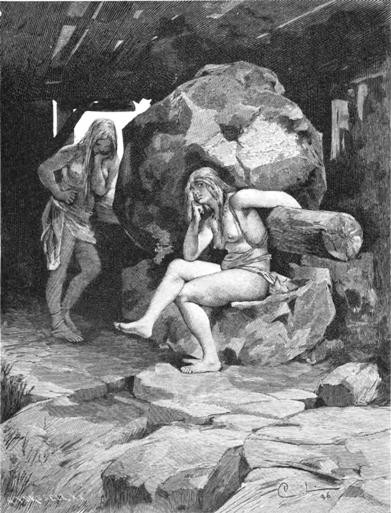 Fenja and Menja at the Grotti-Mill |
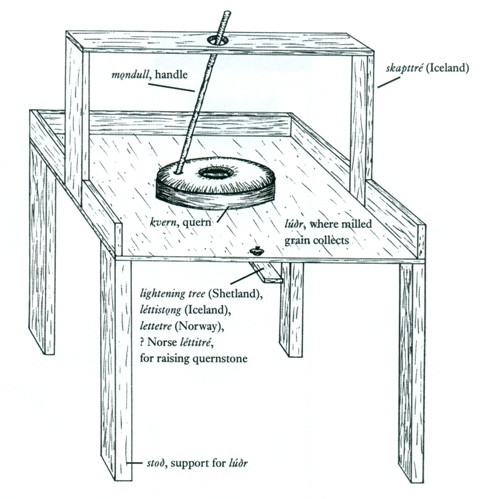 Lúðr: A Quern and Mill-stand |
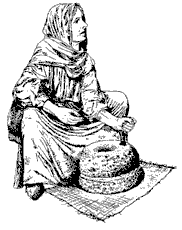 A Hand Quern |
Thus, we find the death of Ymir associated with at least one means of food production. Nor is it by accident.
Purusa6 When Gods prepared the sacrifice with
Purusa as their offering, |
In the Hindu account, not only are the regions of the world formed from Purusa's body, but the social castes are as well. Those emanating from his head and the more noble regions of his body have a higher social standing than those which developed out of his lower extremities. Although less stratified, we also find a heirarchical social order in Old Norse society, divided into Jarls (Nobility) from which the first King (Kon) issues, Karls (Freemen) and Thralls. Likewise, the Old Norse castes receive divine approval through the god Heimdall, who comes among men as Rig and sanctifies them.
Here the giant Purusa is expressly said to have been sacrificed by the gods. In the Norse records, we also find evidence to suggest that Ymir was slaughtered in a sacrifical manner (see below). Since Ymir, as the first being, appears alongside a cow, who arises in like fashion, it is not inconcievable that he was seen as a bull, symbolically. Like an animal sacrifice performed to obtain meat, both Purusa and Ymir are dismembered. This symbolic equality would naturally draw a connection between the first ritual sacrifice used to create the world, and all subsequent ritual sacrifices (both animal and human), intended to sustain the world. Thus, each act of sacrifice, on a smaller scale, was likely intended to replicate the initial act of creation.
| For further insights see The Symbolism of Sacrifice |
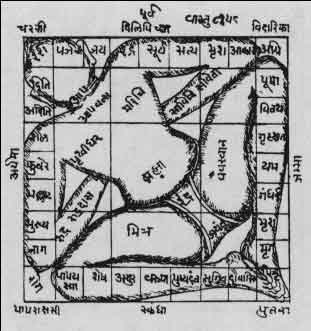 |
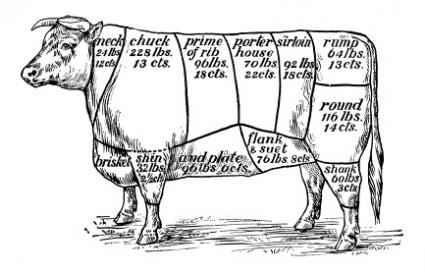 |
| En þar sem heitir Hoddmímisholt leynask menn tveir í Surtaloga er svá heita: Líf ok Leifþrasir, ok hafa morgindöggvar fyrir mat. En af þessum mönnum kemr svá mikil kynslóð at byggvisk heimr allr, svá sem hér segir: | In the place called Hoddmímir's Holt there shall lie hidden during the Fire of Surtr two of mankind, who are called thus: Líf and Lífthrasir, and for food they shall have the morning-dews. From these folk shall come so numerous an offspring that all the world shall be peopled, even as is said here: | ||
|
Líf ok Leifþrasir, |
Líf and Lífthrasir, | these shall lurk hidden
In the Holt of Hoddmímir; The morning dews | their meat shall
be; Thence are gendered the generations. |
The Uppsala Codex U instead reads :
| En í holdi Mímis leynask meyjar í Svartaloga: | Then in Mimir's flesh there shall lie hidden maidens during Surt's fire: | ||
|
Líf ok Lífþræsir, |
Líf and Lífthrasir, |
The word hold means "flesh" as well as "edible meat", and as a descriptive term is especially applicable to cattle:
| HOLD, n.
[Anglo-Saxon hold; Danish huld; Swedish hull]
1. flesh; Ýmis hold, Vþm. 21; svörðr ok hold, skin and
flesh, Eg. 770; hold né bein, Ephesians v. 30, Luke xxiv.
39; hold ok bein, flesh and bone; hold af mínu holdi,
flesh of my flesh Genesis ii. 23: phrases, hold ok hjarta,
flesh and heart, Hm. 95; 2. edible flesh, meat = kjöt; beru hold, bear's flesh, Völunðarkviða 9; bjarnar hold, Sks. 191; lambs hold, lamb's flesh, Homily 82; 3. fleshiness, stoutness, fatness, especially of cattle. [Cleasby/Vigfusson Dictionary] |
This may be significant, if we interpret Ymir as the first sacrifice, after which all subsequent sacrifices are patterned. The giants can then be seen as the sacrifical victims of the gods.
When we examine the ancient records, a pattern begins to emerge in regard to the fate of the oldest giants. Many of them lose their heads.
Ymir, we know is decapitated. A poetic allusion by Egil Skallagrimson informs us that he died of a neck-wound, and both Grímnismál 40 and Vafþrúðnismál 21 tell us that the sky is formed from his severed head.
Mimir too is decapitated. Odin preserves his head, using it as an oracle (Ynglingasaga 4).
In Vafþrúðnismál 19, we learn that the loser in the contest of wisdom between Odin and the old giant Vafthrudnir must forfeit his head. Vafthrudnir of course loses the contest and therefore his head.
Similarly, Loki, who is of giant descent, bets against the dwarf Brokk, wagering his head that Brokk's brother Sindri cannot make better works than the sons of Ivaldi (Skáldskaparmál 43). Loki, through a clever ruse, is allowed to keep his head. According to Gylfaginning, during Ragnarök, Loki and Heimdall will mutually slay one another. While in Skáldskaparmál we learn that a sword can be called "Heimdall's head' because Heimdall will be killed by a man's head. Since he and Loki kill one another, we may reasonably conclude that Loki's severed head somehow seals Heimdall's fate. The details of the myth, however, have been lost to us.
Since Loki forfeited his head in a bet, and kept it through trickery, it would be poetic justice if he lost it in the end. We find a clue in Book 8 of Saxo's History, regarding how a head might be used as a weapon. There a band of human adventerors enter the underworld, and encounter a bound giant designated as Utgarthilocus (a Latinized form of the name Utgard-Loki, found in Snorri's Edda belonging to a giant who cannot be Thor's companion Loki). Chained in the lower world's places of punishment, Saxo's Utgarthilocus thereby resembles the real Loki, who was captured by the gods and bound with the entrails of his son after they learned of his role in Baldur's death. Of this bound giant, Saxo says that his hair and beard grew out hard like horn, resembling spears of cornel:
| Ex qua item atrum obscenumque conclave visentibus aperitur. 5 Intra quod Utgarthilocus manus pedesque immensis catenarum molibus oneratus aspicitur, cuius olentes pili tam magnitudine quam rigore corneas aequaverant hastas. 6 Quorum unum Thorkillus, adnitentibus sociis, mento patientis excussum, quo promptior fides suis haberetur operibus, asservavit; statimque tanta foetoris vis ad circumstantes manavit, ut nisi repressis amiculo naribus respirare nequirent. | A foul and gloomy room was disclosed to the visitors, wherein they saw Utgard-Loki, laden hand and foot with enormous chains. Each of his reeking hairs was as large and stiff as a spear of cornel. Thorkill (his companions lending a hand), in order that his deeds might gain more credit, plucked one of these from the chin of Utgarda-Loki, who suffered it. Straightway such a noisome smell reached the bystanders, that they could not breathe without stopping their noses with their mantles. |
Sacrifical animals are typically slain by a blow to the head with a blunt object, such as a hammer. Their bodies are then hung in an inverted position to drain the blood. This is done by making an incision in the jugular vein, found in the neck. Afterwards, the animal is decapitated and dismembered for its meat. In heathen times, this was most likely done in a ritual fashion. In that light, we may see Thor's continuous battle with giants in terms of human sacrifice.
The equation of giants with cattle informs the symbolism. Thor typically slays his giant-opponents by throwing his hammer against their heads. He is frequently said to crush their skulls. In Thorsdrapa, the giants are referred to as the cattle of Alfheim. According to Grímnismál 4, Thor's home Thrudheim lies closest to the Aesir and the elves. Likewise, when Thor enters Hymir's herd to obtain fishing bait, he wrings the head off of Hymir's prize bull. The poet expresses this in vivid terms, saying that Thor made the steer "shorter by a head". The Viking Age site at Hofstaðir, Iceland provides physical evidence of such ritual killing.
|
The association of the site of Hofstaðir as a pagan temple or a large feasting hall with a shrine, comes from the recovery of at least 23 individual cattle skulls, located in three distinct deposits. Cutmarks on the skulls and neck vertebrae suggest that the cows were killed (by a blow to the forehead) and beheaded while still standing; weathering of the bone suggests that the skulls were displayed outside for a number of months or years after the soft tissue had decayed away. The cattle skulls are in three clusters, an area on the west exterior side containing 8 skulls; 14 skulls inside a room adjoining to the great hall (the 'shrine'), and one single skull located next to the main entry way. All of the skulls were found within wall and roof collapse areas, suggesting that they had been suspended from the roof rafters. Radiocarbon dates on five of the skulls the bone suggest that the animals died between 50-100 years apart, with the latest dated about AD 1000. Excavators Lucas and McGovern believe that Hofstaðir ended abruptly in the mid-11th century, about the same time a church was built 140 meters away. [Icelandic Viking Site of Hofstadir By K. Kris Hirst ] |
Besides killing giants, Thor's hammer is also used to hallow brides, and to resurrect his goats, after they have been ritually slain and eaten. Thus, ritual slaughter can be seen as part of a greater cycle of death and regeneration, closely associated with the production of food (both meat and produce).
The fact that so many of the mythology's ancient giants die by decapitation, and that Thor crushes the skulls of so many others, points towards a symbolic significance behind the act itself, directly related to heathen sacrifical practices. This may find meaning in this context, in that, once the poem concludes, the ending prose relates how King Geirrod falls upon his own sword and dies in the presense of Odin, after he has revealed his divinity.
Death by sword can be construed as a sacrifice to Odin. And, Geirröd, perhaps not coincidentally, is also the name of a famous giant, killed by Thor.
[PREVIOUS][MAIN][NEXT]
[HOME]